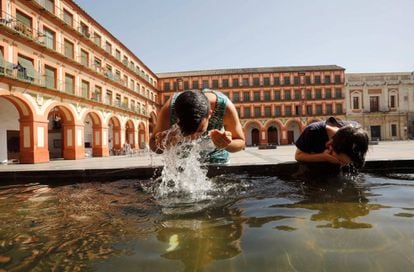EL PAÍS enriches weather info with new indicators to monitor climate change
Daily figures for carbon dioxide, reservoir water levels and air quality will be provided in an interactive way, allowing readers to compare current numbers with historical data sets

The highly intuitive Prussian scientist Alexander von Humboldt posited a worrisome theory more than two centuries ago: that human action could influence and modify local climates. He came to this conclusion after a fruitful exploration trip through Latin America in the early 19th century, when he took note of the agricultural techniques that were being used by the settlers.
Today, the scientific community almost unanimously agrees that our planet is experiencing climate change due to human actions, and more specifically due to the greenhouse gas emissions produced by our daily activities, which are causing the Earth’s atmosphere to get warmer.
People are starting to worry about indicators that nobody was paying attention to before
Juan Antonio Añel, physicist
We are now getting constant confirmation about what used to be a mere hypothesis just 20 to 30 years ago: average temperatures are increasing and we are seeing a proliferation of extreme weather events such as heatwaves, hurricanes or prolonged drought. For instance, last month was the warmest June on record, and in May the levels of carbon dioxide, the main greenhouse gas, reached previously unseen figures.
In response to this environmental crisis, EL PAÍS has decided to make some changes to the weather information it has been providing it Spanish readers with for the last 43 years. The weather section of the print edition, which is coordinated by Jorge Luis Ron, a physicist specializing in meteorology, now includes daily indicators of carbon dioxide concentration, air quality, average historical temperatures and water levels at reservoirs.
“On the one hand, we want to provide a climate-based context for meteorological information,” says Bernardo Marín, one of the assistant editors at EL PAÍS. “On the other, we want to raise reader awareness about global warming.”
The online edition now also includes a special section (currently only available in Spanish) created by our data team under the guidance of Daniele Grasso. This section lets readers compare the latest average temperature in 56 Spanish cities with past average temperatures at that same spot. This way, readers can check whether it really is much hotter or colder than normal for this time of the year, compared with historical data sets. This is the first of several new meteorology and environment-focused online projects that will see the light in the coming months.
We want to raise reader awareness about global warming
Bernardo Marín, EL PAÍS assistant editor
Similarly, readers will be able to check the current water levels at reservoirs associated with Spain’s seven main waterways: the Duero, Tajo, Guadiana, Guadalquivir, Ebro, Júcar and Segura rivers. Averages for the last 10 years will be provided for context.
“It is essential to help readers put the weather information in context. That way, the weather stops being merely an information service and helps us understand climate change.” says Cristina Monge, a political scientist and member of the green group Ecodes, noting that other news organizations such as UK daily The Guardian are already offering similar indicators.
“People are starting to worry about indicators that nobody was paying attention to before,” explains Juan Antonio Añel, a physicist and expert on climate change. “Now people are concerned about things like pollution.”
English version by Susana Urra.











































